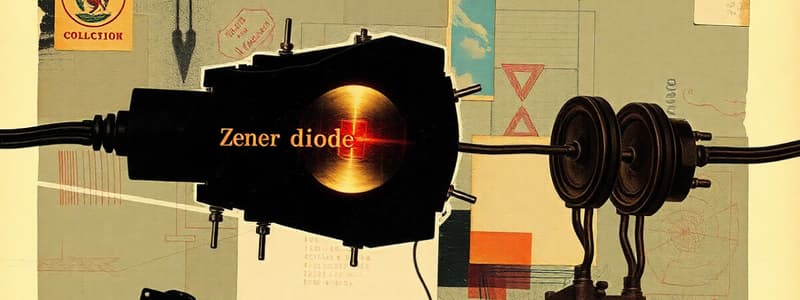Podcast
Questions and Answers
What is the aim of Experiment No. 13?
What is the aim of Experiment No. 13?
To study the characteristics of Zener diode in reverse bias and determine its reverse breakdown voltage.
Which apparatus is NOT used in the Zener diode experiment?
Which apparatus is NOT used in the Zener diode experiment?
- Resistor (correct)
- DC power supply
- Milliameter
- Voltmeter
What does the Zener diode regulate?
What does the Zener diode regulate?
Voltage across a load
In the Zener diode circuit, the Zener is connected in ______ with the load.
In the Zener diode circuit, the Zener is connected in ______ with the load.
At what input voltage does the Zener diode reach its breakdown voltage?
At what input voltage does the Zener diode reach its breakdown voltage?
As the input voltage increases beyond the breakdown voltage, the output voltage across the Zener diode remains constant.
As the input voltage increases beyond the breakdown voltage, the output voltage across the Zener diode remains constant.
What is the output voltage across the Zener diode at an input voltage of 12.2 volts?
What is the output voltage across the Zener diode at an input voltage of 12.2 volts?
Explain the significance of the steep slope on the graph of Zener diode characteristics.
Explain the significance of the steep slope on the graph of Zener diode characteristics.
Match the following parameters with their values based on the observation table:
Match the following parameters with their values based on the observation table:
Flashcards are hidden until you start studying
Study Notes
Experiment Overview
- This experiment aims to study the characteristics of a Zener diode in reverse bias and determine its breakdown voltage.
- The experiment uses a DC power supply, milliameter, voltmeter, connecting wires, and a Zener diode.
Zener Diode Function
- The Zener diode operates in reverse bias and is designed to regulate voltage across a load when input voltage or load current fluctuates.
- The Zener diode, along with a resistor (RS), is connected in parallel to the load (RL) to form a Zener regulator circuit.
- The breakdown voltage of the Zener diode (Vz) determines the output voltage across the load.
Experimental Setup
- The experimental setup has a variable DC power supply, a resistor, a Zener diode, and a load resistor.
- The input voltage (Vi) is varied, and the current through the Zener diode (Iz) and voltage across it (Vz) are measured.
Experimental Results and Graph
- The observation table summarizes the collected data showing input voltage (Vi), current through the Zener (Iz), and voltage across the Zener (Vz).
- The graph represents the relationship between Vz and Iz, plotted as a curve with negative X and Y axes.
- The graph exhibits a steep slope initially, followed by a plateau after the breakdown voltage.
- The breakdown voltage for this particular Zener diode is estimated at approximately 6.78 volts.
Interpretation
- The graph demonstrates that as the input voltage increases beyond the breakdown voltage, the current increases significantly, but the output voltage remains relatively constant.
- This behavior highlights the voltage regulation capability of the Zener diode.
- The Zener diode effectively stabilizes the output voltage against variations in input voltage.
Studying That Suits You
Use AI to generate personalized quizzes and flashcards to suit your learning preferences.




